29.6: 哺乳动物
- Page ID
- 203160
培养技能
- 命名和描述三大哺乳动物群体的显著特征
- 描述产生哺乳动物的拟议血统
- 列出一些可能因哺乳动物需要持续、高水平的新陈代谢而产生的衍生特征
哺乳动物是拥有毛发和乳腺的脊椎动物。 哺乳动物还有其他一些特征,包括下巴、骨骼、外皮和内部解剖结构的某些特征。 现代哺乳动物属于三个进化枝:单极动物、有袋动物和欧瑟里动物(或胎盘哺乳动物)。
哺乳动物的特征
毛发的存在是哺乳动物最明显的征兆之一。 尽管毛发对某些物种(例如鲸鱼)不是很广泛,但对哺乳动物具有许多重要功能。 哺乳动物具有吸热作用,头发提供隔热以保持新陈代谢工作产生的热量。 头发在身体附近捕获一层空气,保持热量。 除了隔热外,头发还可以通过称为 vibrissae 的特殊头发(俗称胡须)作为一种感官机制。 它们附着在传递感觉信息的神经上,这对于夜间活动或挖洞的哺乳动物特别有用。 头发还可以提供保护性着色或成为社交信号的一部分,例如当动物的头发 “直立” 时。
哺乳动物的外皮或皮肤包括具有各种功能的分泌腺。 皮@@ 脂腺产生一种称为皮脂的脂质混合物,该混合物分泌到头发和皮肤上,起到防水和润滑作用。 皮脂腺位于身体的大部分部位。 Eccrine 腺会产生汗液或汗水,汗水主要由水组成。 在大多数哺乳动物中,内分泌腺仅限于身体的某些部位,有些哺乳动物根本不拥有它们。 但是,在灵长类动物中,尤其是人类中,汗液在体温调节中占有突出地位,通过蒸发冷却调节身体。 汗腺位于灵长类动物的大部分体表上。 顶泌腺或气味腺体分泌用于化学交流的物质,例如臭鼬。 乳腺产生用于喂养新生儿的牛奶。 虽然雄性 monotremes 和 eutherians 拥有乳腺,但雄性有袋动物没有。 乳腺可能是改良的皮脂腺或内分泌腺,但其进化起源尚不完全清楚。
哺乳动物的骨骼系统具有许多独特的特征。 哺乳动物的下颌仅由一根骨头组成,即牙齿。 其他脊椎动物的下巴由一根以上的骨头组成。 在哺乳动物中,牙齿骨在鳞骨处连接头骨,而在其他脊椎动物中,下巴的方形骨与头骨的关节骨相连。 这些骨骼存在于哺乳动物中,但它们已被改造为具有听觉功能并在中耳形成骨头(图\(\PageIndex{1}\))。 其他脊椎动物只有一根中耳骨,即葡萄球菌。 哺乳动物有三种:槌、incus 和葡萄球菌。 锤起源于关节骨,而 incus 起源于方骨。 这种颚骨和耳骨的排列有助于将化石哺乳动物与其他突触的化石区分开来。
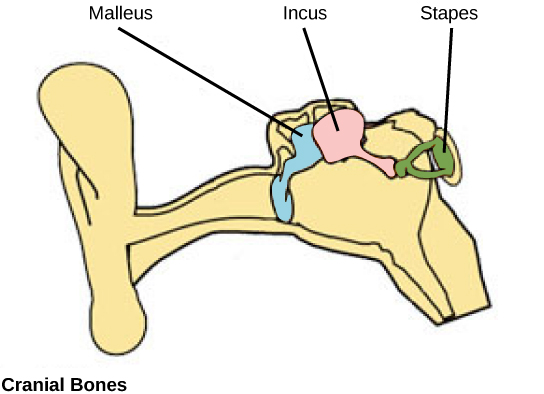
闭合下巴的内收肌由哺乳动物中的两块肌肉组成:腱肌和咬肌肌肉。 它们允许下巴左右移动,使咀嚼成为可能,这是哺乳动物独有的。 大多数哺乳动物都有异牙牙,这意味着它们有不同类型和形状的牙齿,而不仅仅是一种类型和形状的牙齿。 大多数哺乳动物都是 diphyodonts,这意味着它们一生中有两组牙齿:乳牙或 “婴儿” 牙齿和恒牙。 其他脊椎动物是 polyphyodonts,也就是说,它们的牙齿一生都会被替换。
哺乳动物和鸟类一样,拥有一颗四腔心脏。 哺乳动物的右心房壁上还有一组专门的心纤维,称为窦房结或起搏器,它决定了心跳的速度。 哺乳动物的红细胞(红细胞)没有核,而其他脊椎动物的红细胞是有核的。
哺乳动物的肾脏有一部分叫做 Henle loop of Henle 或 nephritic loop,它允许哺乳动物产生溶质浓度高于血液浓度的尿液。 哺乳动物缺乏肾门系统,肾门系统是一种静脉系统,将血液从后肢或下肢以及尾巴区域转移到肾脏。 除无颚鱼类外,所有其他脊椎动物中都存在肾门系统。 所有哺乳动物中都存在膀胱。
哺乳动物的大脑具有与其他脊椎动物不同的某些特征。 在一些但不是所有的哺乳动物中,大脑最外层的大脑皮层高度折叠,与光滑皮层相比,其表面积更大。 位于中脑的视叶在哺乳动物中分为两部分,而其他脊椎动物则拥有单个不可分割的叶。 Eutherian 哺乳动物还具有连接两个大脑半球的特殊结构,称为 callosum 语料库。
哺乳动物的进化
哺乳动物是突触,这意味着它们的头骨只有一个开口。 它们是唯一活的突触,因为早期的形态在侏罗纪时期已经灭绝。 早期的非哺乳动物突触可以分为两组,即 pelycosaurs 和 therapsids。 在疗法中,一个叫做 cynodonts 的群体被认为是哺乳动物的祖先(图\(\PageIndex{2}\))。
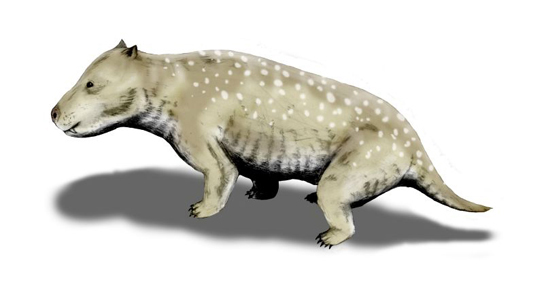
synapsids 的一个关键特征是吸热,而不是大多数其他脊椎动物所见的外热。 内部改变体温所需的新陈代谢率的提高与某些骨骼结构的变化齐头并进。 后来的突触具有哺乳动物独有的更多进化特征,它们具有用于存放食物的脸颊和异牙齿,它们专门用于咀嚼、机械分解食物以加速消化和释放产生热量所需的能量。 咀嚼还需要同时咀嚼和呼吸的能力,次要味蕾的存在有助于咀嚼和呼吸。 次要味觉将进行咀嚼的口腔区域与上方呼吸的区域分开,从而允许在咀嚼过程中不间断地进行呼吸。 在 pelycosaurs 中没有发现次要味蕾,但存在于 cynodonts 和哺乳动物中。 颚骨还显示了从早期突触到晚期突触的变化。 颧弓或颧骨存在于哺乳动物和 cynodonts 等高级疗法中,但在 pelycosaurs 中不存在。 颧弓的存在表明有咬肌的存在,它会闭合下巴并起到咀嚼的作用。
在阑尾骨骼中,therian 哺乳动物的肩带与其他脊椎动物的肩带进行了改造,因为它没有 procoracoid 骨或锁骨间,而肩腱是占主导地位的骨骼。
哺乳动物是从三叠纪晚期的疗法进化而来的,因为已知最早的哺乳动物化石来自大约2.05亿年前的侏罗纪早期。 早期的哺乳动物很小,大约相当于小型啮齿动物的大小。 哺乳动物最早在中生代(从侏罗纪到白垩纪)开始多样化,尽管这些哺乳动物中的大多数在中生代末期已经灭绝。 在白垩纪,哺乳动物的另一种辐射开始并持续到大约6500万年前的新生代时代。
活哺乳动物
eutherians 或胎盘哺乳动物和有袋动物共同构成了 therian 哺乳动物的进化枝。 Monotremes 或 metatherians 构成了他们的姐妹进化枝。
m onotremes 有三种活物种:鸭嘴兽和两种针鼹或多刺食蚁兽。 皮喙鸭嘴兽属于 Orn ithorhynchidae(“鸟嘴”)家族,而针鼹属于 T achyglossidae(“粘舌”)家族(图\(\PageIndex{3}\))。 鸭嘴兽和一种针鼹在澳大利亚被发现,另一种针鼹在新几内亚被发现。 Monotremes 在哺乳动物中是独一无二的,因为它们会产卵,而不是生下活着的孩子。 它们的卵壳不像鸟的硬壳,而是皮质外壳,类似于爬行动物卵的壳。 Monotremes 没有牙齿。
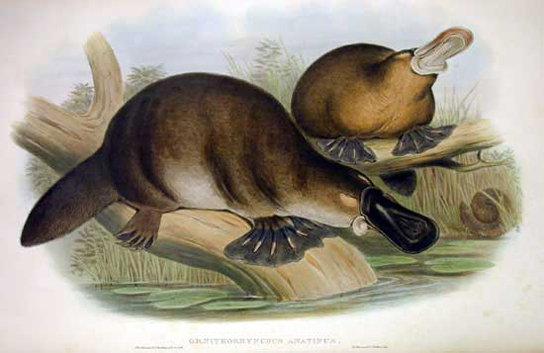
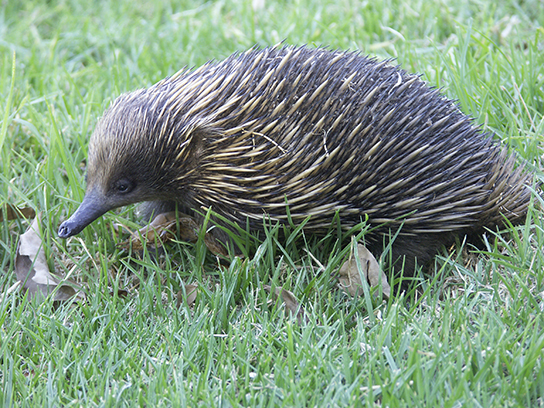
Marsupials are found primarily in Australia, though the opossum is found in North America. Australian marsupials include the kangaroo, koala, bandicoot, Tasmanian devil (Figure \(\PageIndex{4}\)), and several other species. Most species of marsupials possess a pouch in which the very premature young reside after birth, receiving milk and continuing to develop. Marsupials differ from eutherians in that there is a less complex placental connection: The young are born at an extremely early age and latch onto the nipple within the pouch.
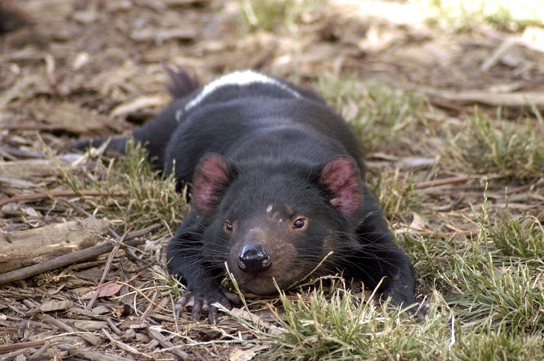
Eutherians are the most widespread of the mammals, occurring throughout the world. There are 18 to 20 orders of placental mammals. Some examples are Insectivora, the insect eaters; Edentata, the toothless anteaters; Rodentia, the rodents; Cetacea, the aquatic mammals including whales; Carnivora, carnivorous mammals including dogs, cats, and bears; and Primates, which includes humans. Eutherian mammals are sometimes called placental mammals because all species possess a complex placenta that connects a fetus to the mother, allowing for gas, fluid, and nutrient exchange. While other mammals possess a less complex placenta or briefly have a placenta, all eutherians possess a complex placenta during gestation.
Summary
Mammals in general are vertebrates that possess hair and mammary glands. The mammalian integument includes various secretory glands, including sebaceous glands, eccrine glands, apocrine glands, and mammary glands. Mammals are synapsids, meaning that they have a single opening in the skull. A key characteristic of synapsids is endothermy rather than the ectothermy seen in other vertebrates. Mammals probably evolved from therapsids in the late Triassic period, as the earliest known mammal fossils are from the early Jurassic period. There are three groups of mammals living today: monotremes, marsupials, and eutherians. Monotremes are unique among mammals as they lay eggs, rather than giving birth to young. Eutherian mammals are sometimes called placental mammals, because all species possess a complex placenta that connects a fetus to the mother, allowing for gas, fluid, and nutrient exchange.
Glossary
- apocrine gland
- scent gland that secretes substances that are used for chemical communication
- dentary
- single bone that comprises the lower jaw of mammals
- diphyodont
- refers to the possession of two sets of teeth in a lifetime
- eccrine gland
- sweat gland
- eutherian mammal
- mammal that possesses a complex placenta, which connects a fetus to the mother; sometimes called placental mammals
- heterodont tooth
- different types of teeth that are modified for different purposes
- mammal
- one of the groups of endothermic vertebrates that possesses hair and mammary glands
- mammary gland
- in female mammals, a gland that produces milk for newborns
- marsupial
- one of the groups of mammals that includes the kangaroo, koala, bandicoot, Tasmanian devil, and several other species; young develop within a pouch
- monotreme
- egg-laying mammal
- Ornithorhynchidae
- clade that includes the duck-billed platypus
- sebaceous gland
- in mammals, a skin gland that produce a lipid mixture called sebum
- Tachyglossidae
- clade that includes the echidna or spiny anteater


